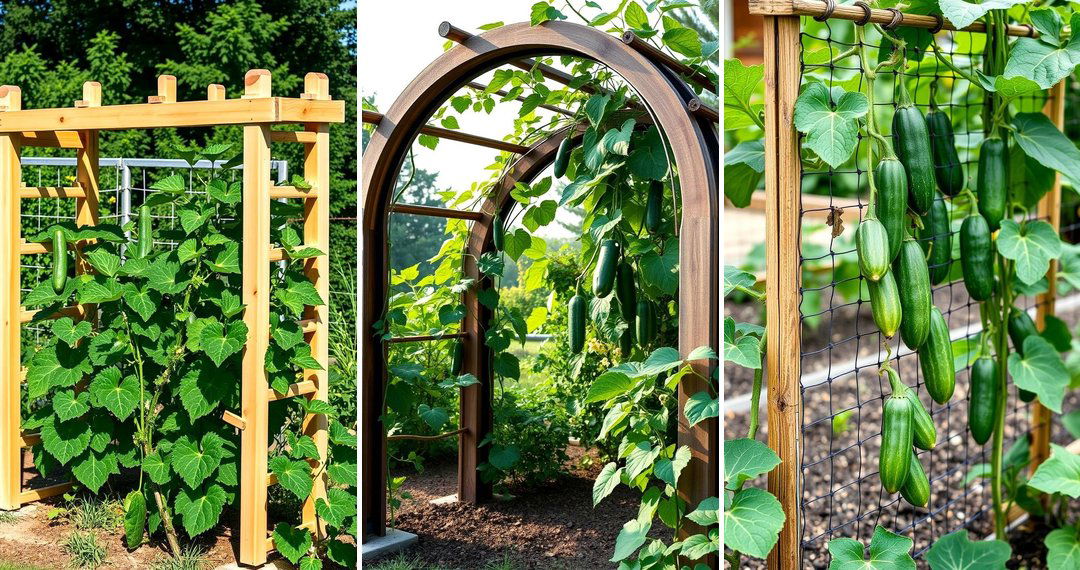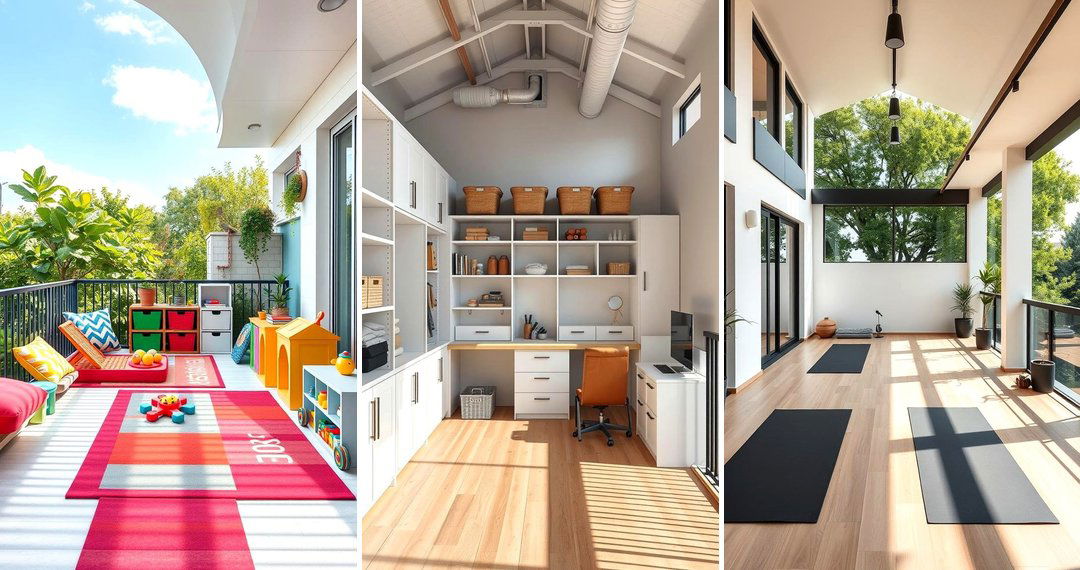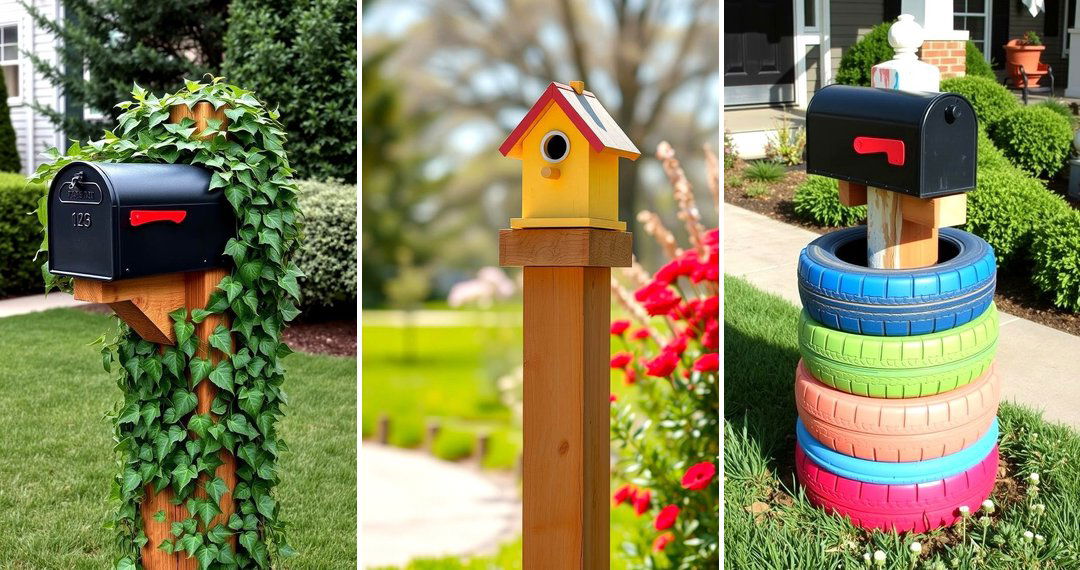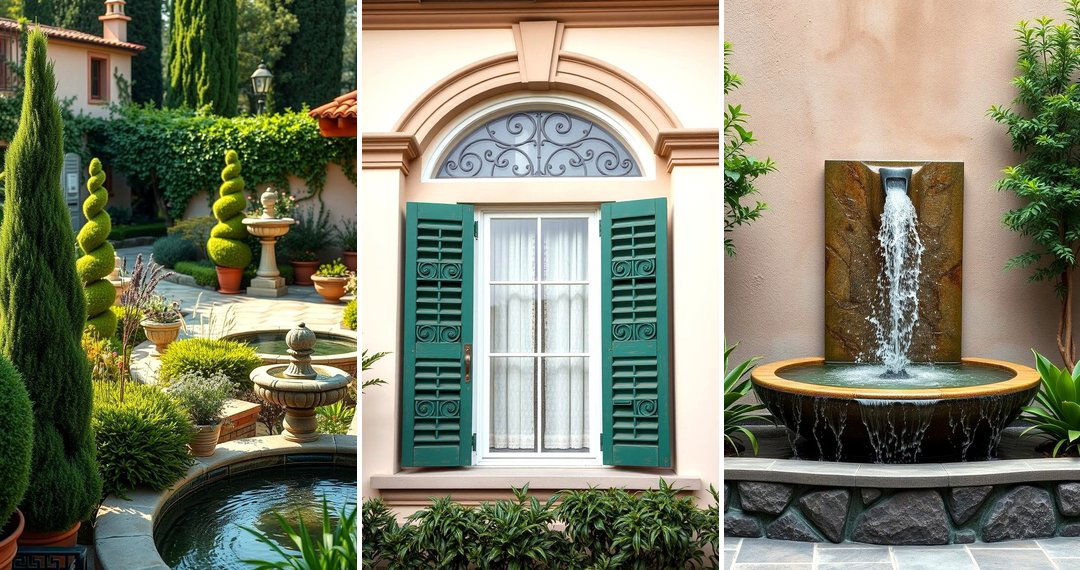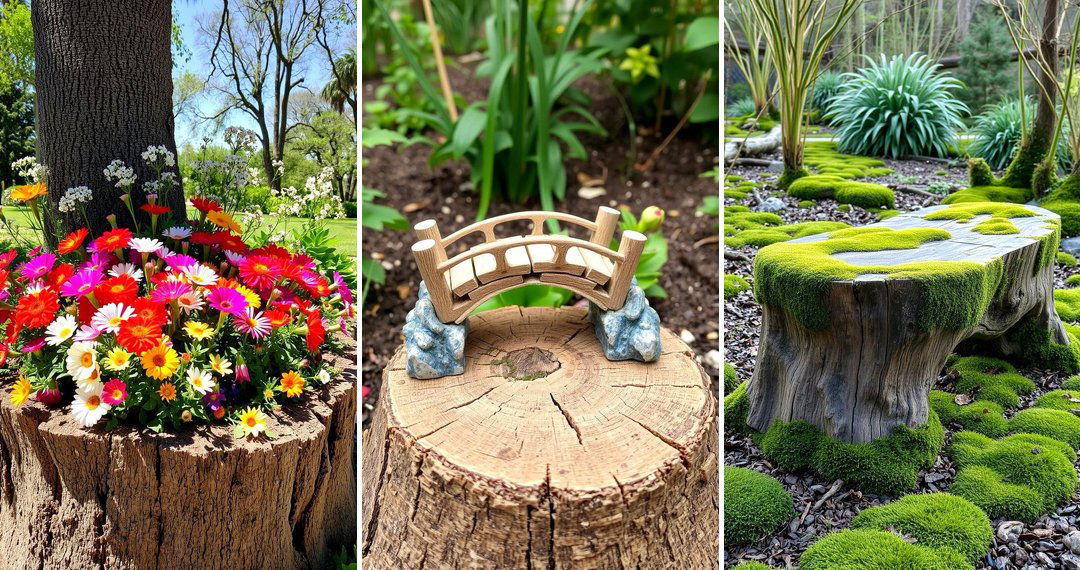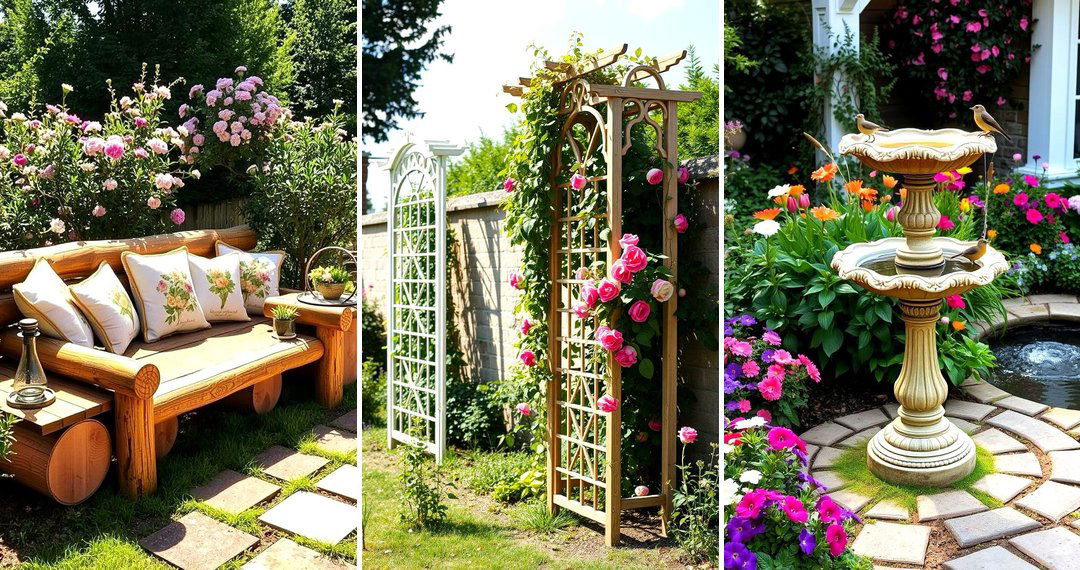Discover the secrets to bountiful tomato harvests with our comprehensive guide to 24 innovative tomato trellis ideas. Whether you're a seasoned gardener or just starting, finding the right support system for your tomato plants is crucial for healthy growth, disease prevention, and easy harvesting. Explore a variety of options, from simple and budget-friendly to more elaborate and decorative designs, each offering unique benefits for different gardening styles and spaces. Dive in to find the perfect trellis solution to elevate your tomato growing experience.
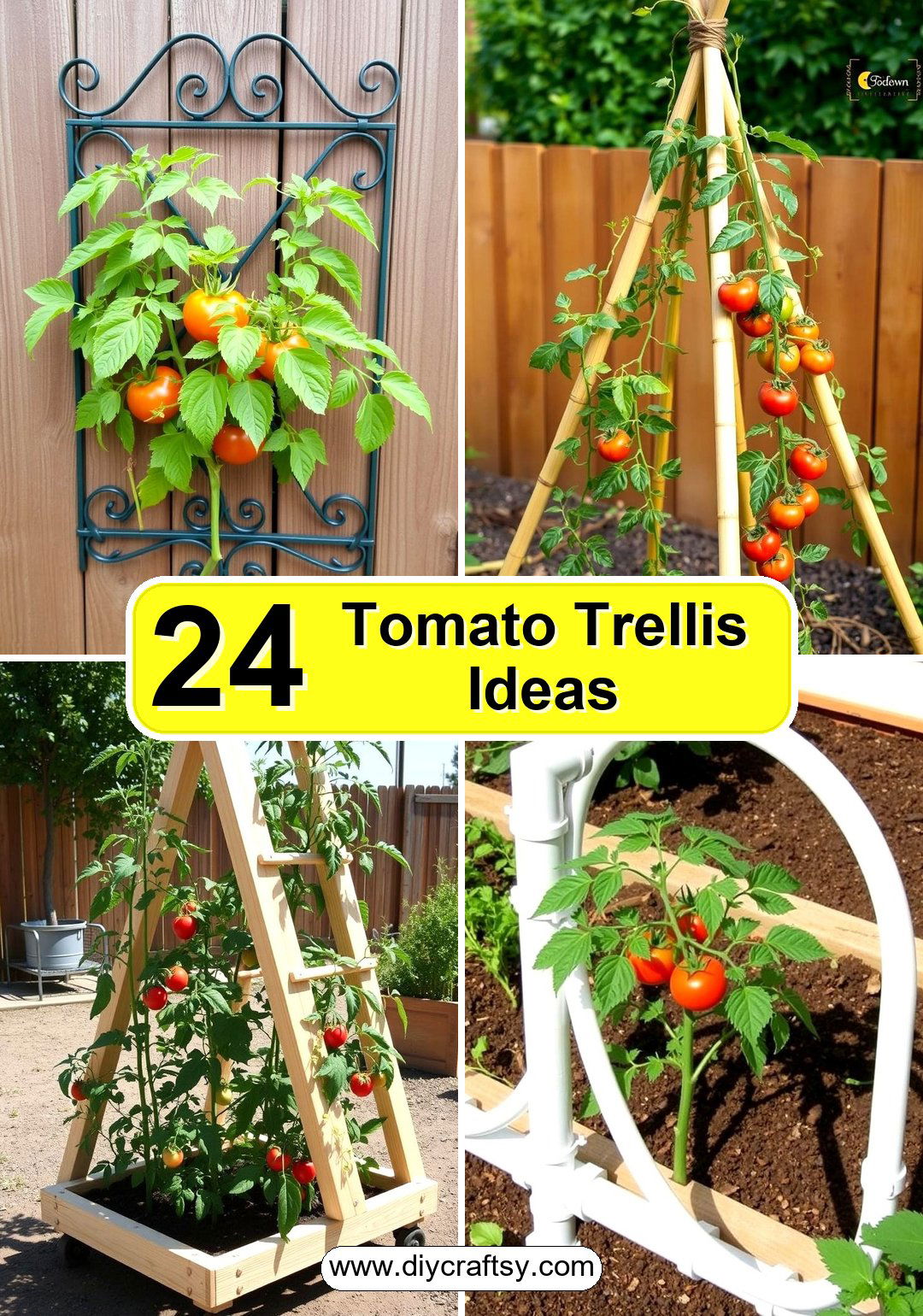
1. Simple Stakes
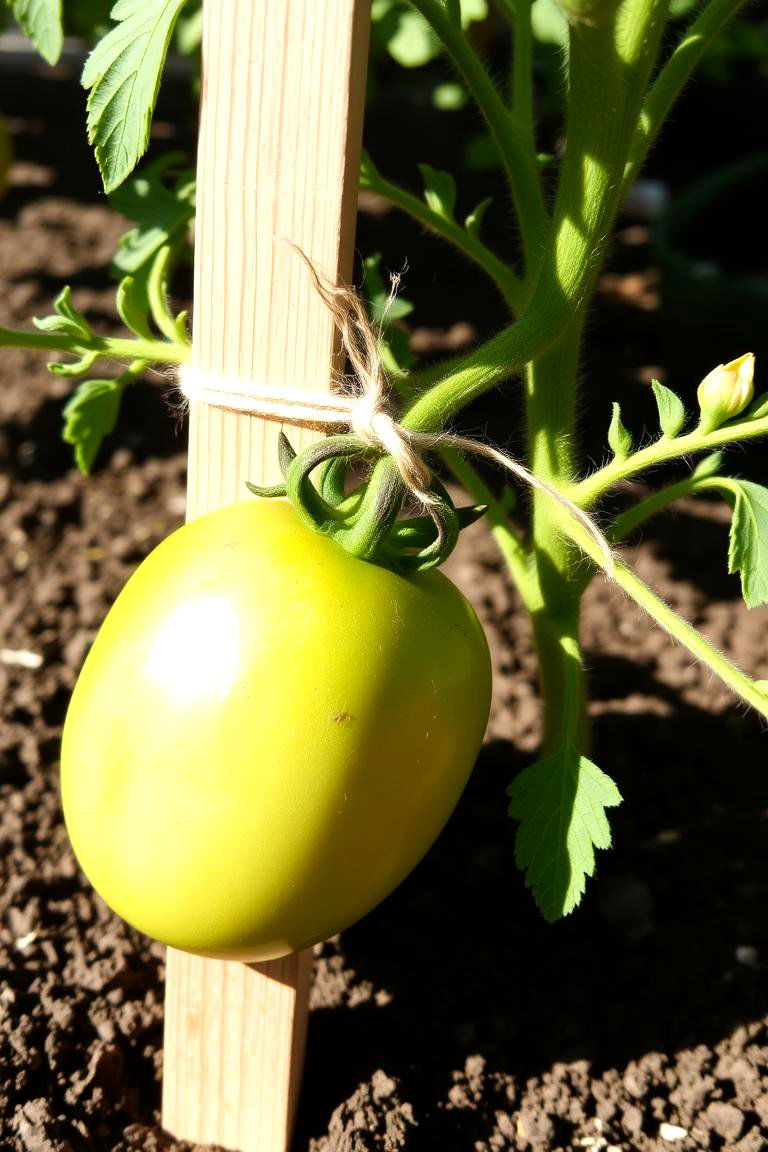
For gardeners seeking an easy and economical solution, single stakes offer fundamental support for individual tomato plants. This straightforward method involves inserting a sturdy stake, typically made of wood or metal, directly into the ground beside the plant. The key benefit lies in its simplicity and minimal cost, making it ideal for beginners or those with a few plants. As the tomato grows, gently tie the main stem to the stake at regular intervals using soft twine or plant ties. This prevents the plant from sprawling on the ground, improving air circulation and reducing the risk of soil-borne diseases.
2. Single String Trellis
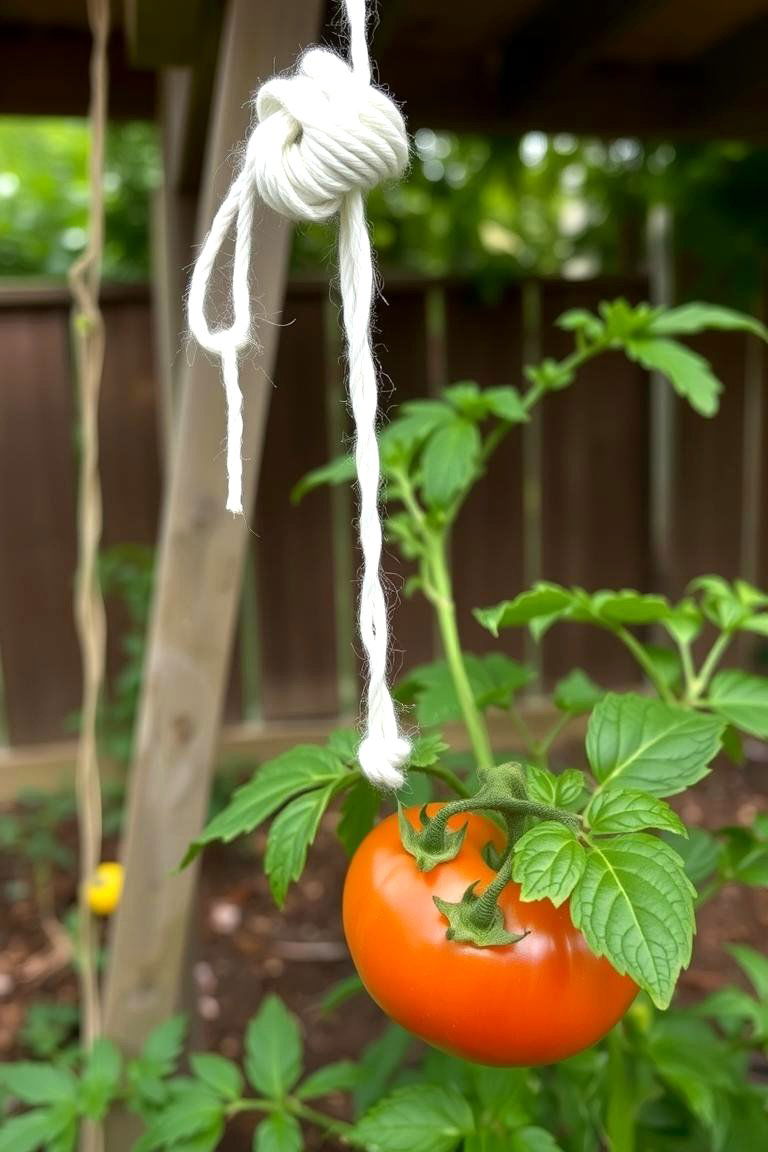
Consider a single string trellis as a space-saving and efficient way to support vining tomato varieties. This method involves suspending a strong string or twine from an overhead support, such as a beam or wire, down to the base of each tomato plant. The primary advantage is its vertical orientation, which maximizes garden space and promotes excellent airflow around the foliage. As the plant grows, you'll need to gently twist the main stem around the string or use clips to secure it. This technique encourages upward growth, leading to cleaner and easier-to-harvest fruits.
3. Florida Weave
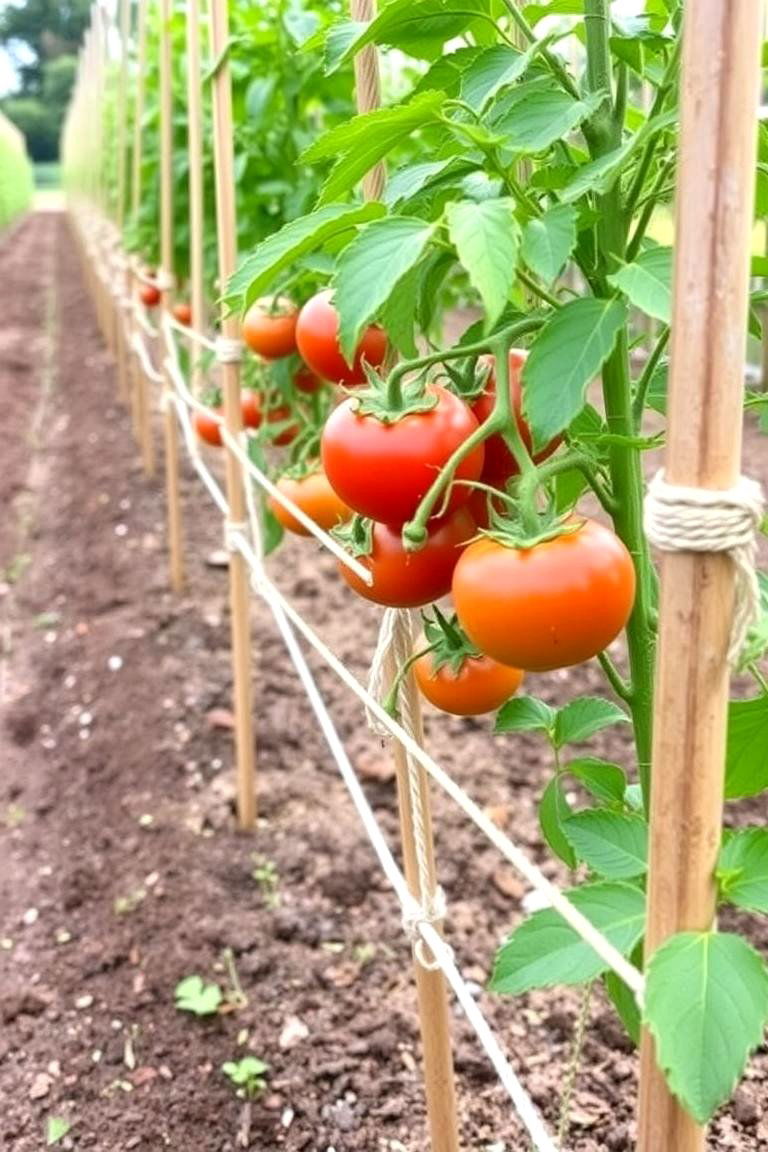
With the Florida weave method, you can efficiently support rows of tomato plants using stakes and twine. This technique involves placing stakes at intervals along the row and then weaving twine horizontally between the stakes on either side of the plants. The main benefit is that it provides support for multiple plants simultaneously, preventing them from falling over as they grow heavy with fruit. This method is particularly well-suited for determinate tomato varieties that tend to bush out. The woven twine cradles the stems, keeping the tomatoes off the ground and improving overall plant health.
4. Cattle Panel Trellis
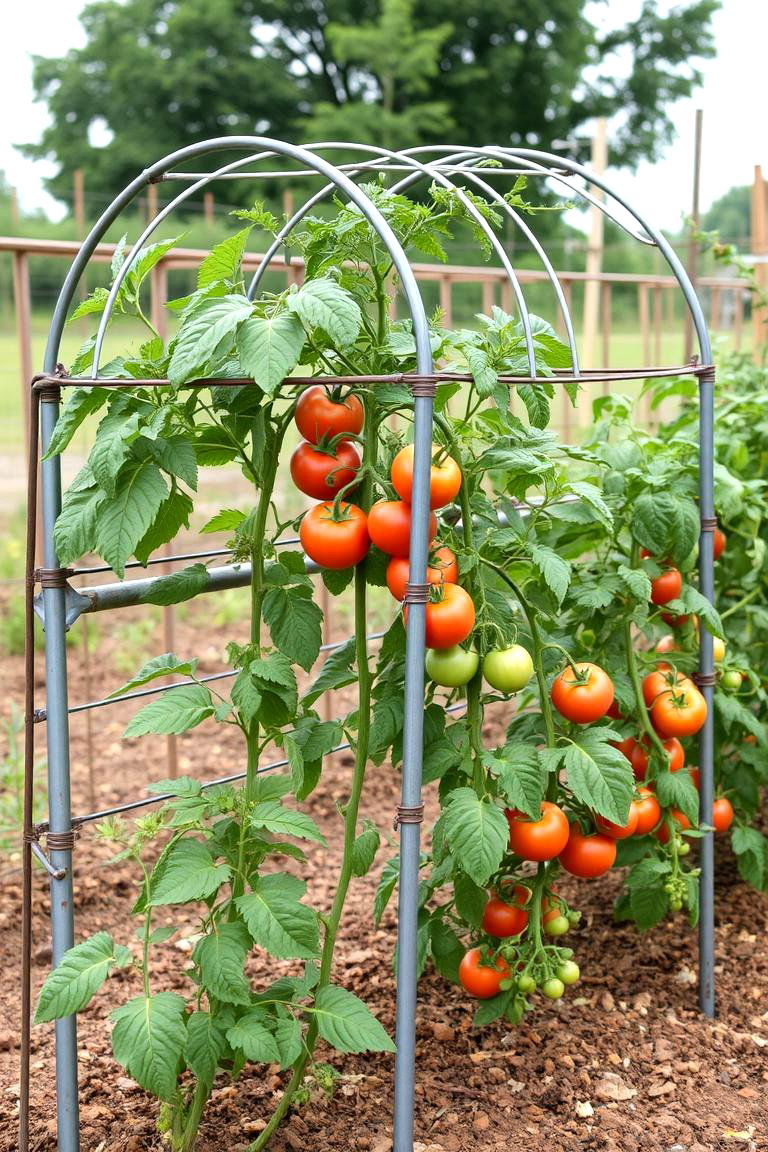
Looking for a robust and long-lasting trellis solution? A cattle panel trellis offers exceptional strength and durability for supporting even the heaviest tomato plants. These panels, typically made of heavy-gauge wire, can be bent into various shapes, such as an arch or a flat vertical structure. The significant advantage is their sturdiness, which can withstand strong winds and the weight of a substantial tomato crop. Simply secure the panel in place using sturdy posts, and the large openings provide ample space for plants to grow through and for easy harvesting.
5. A-Frame Trellis
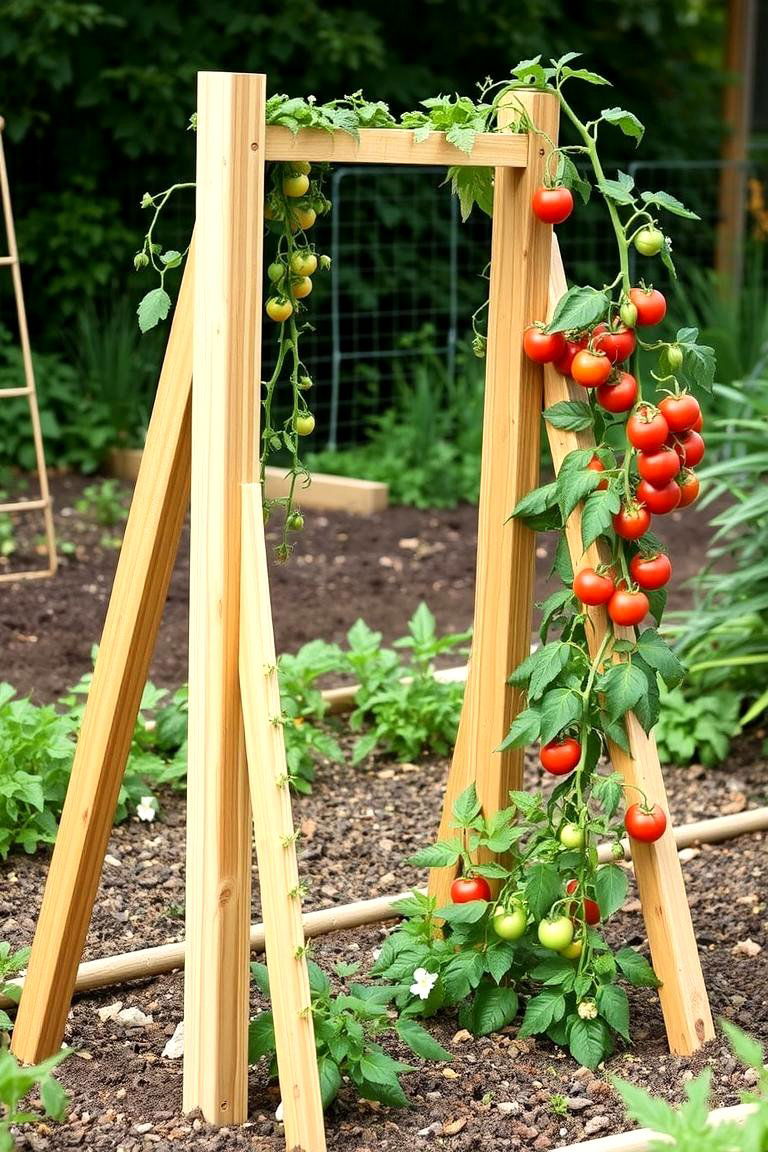
The A-frame trellis design provides a stable and self-supporting structure for your tomato plants. This involves creating two frames, usually from wood or bamboo, and connecting them at the top to form an "A" shape. The key benefit is its inherent stability, eliminating the need for additional support posts. Tomato plants can be grown on both sides of the A-frame, maximizing the use of vertical space. This design also allows for good airflow and sunlight penetration, contributing to healthier and more productive plants.
6. Teepee Trellis
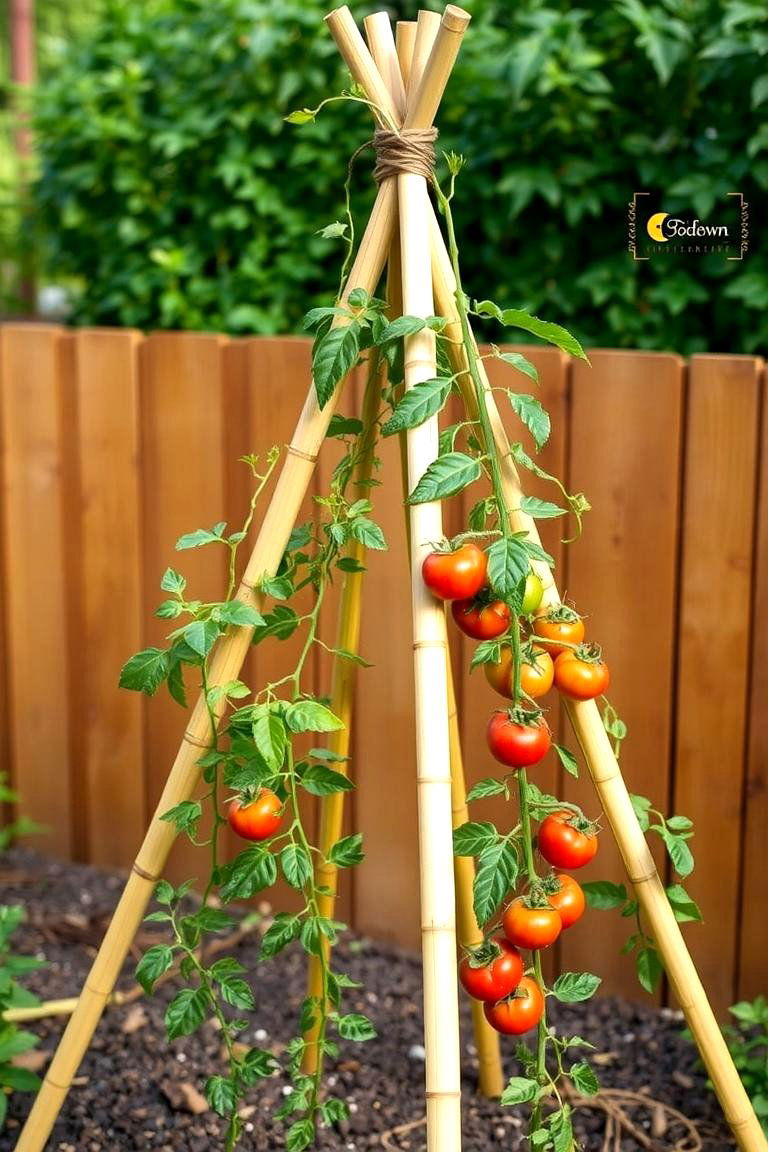
Consider a teepee trellis for an attractive and functional way to support your climbing tomato varieties. This involves arranging three or four sturdy poles, such as bamboo or wooden stakes, in a circle and tying them together at the top to form a cone shape. The aesthetic appeal is a major advantage, making it a visually pleasing addition to any garden. Tomato plants can then be trained to grow up each pole, providing ample support and keeping the fruits off the ground. This method is particularly suitable for smaller gardens or as a decorative element.
7. Spiral Trellis
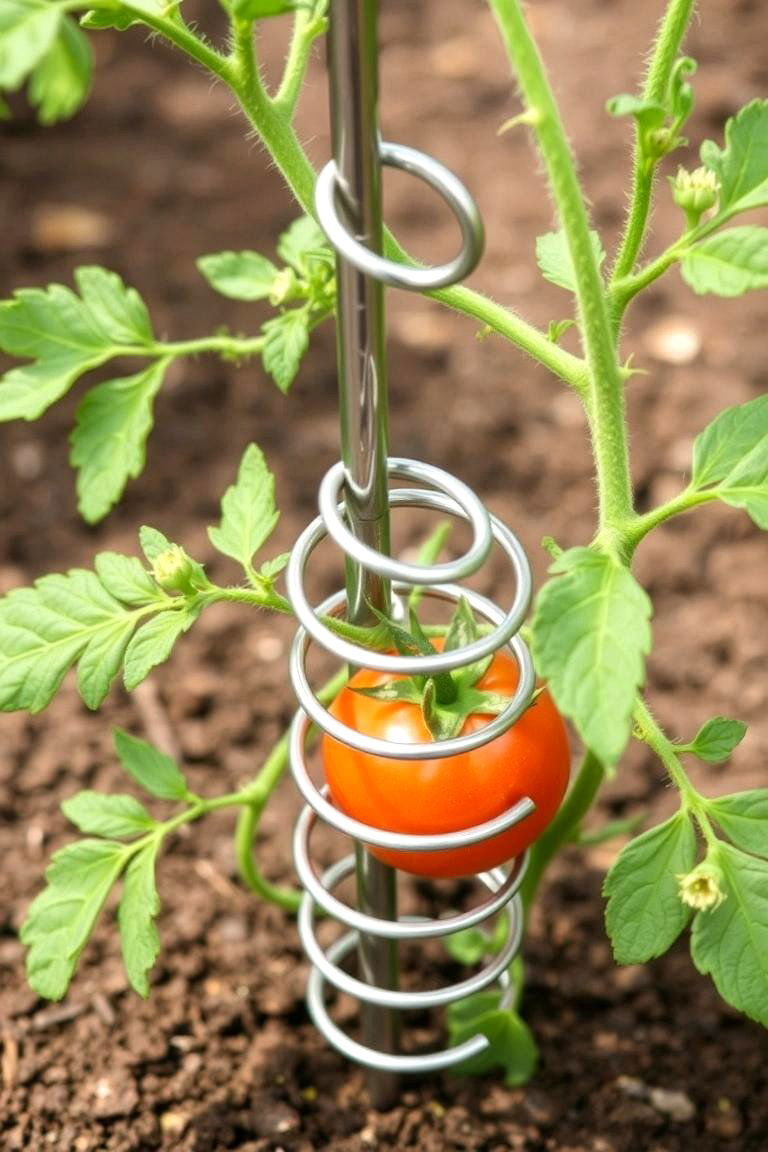
What about a spiral trellis for individual tomato plants that offers continuous support as they grow? These trellises, typically made of metal wire, feature a spiraling design that allows the plant to naturally wind its way upwards. The primary benefit is the consistent support provided along the entire length of the stem, preventing breakage due to wind or heavy fruit. Simply insert the spiral trellis into the ground around the plant, and gently guide the main stem into the spiral as it grows. This is a convenient option for both determinate and indeterminate tomato varieties.
8. Cage Trellis
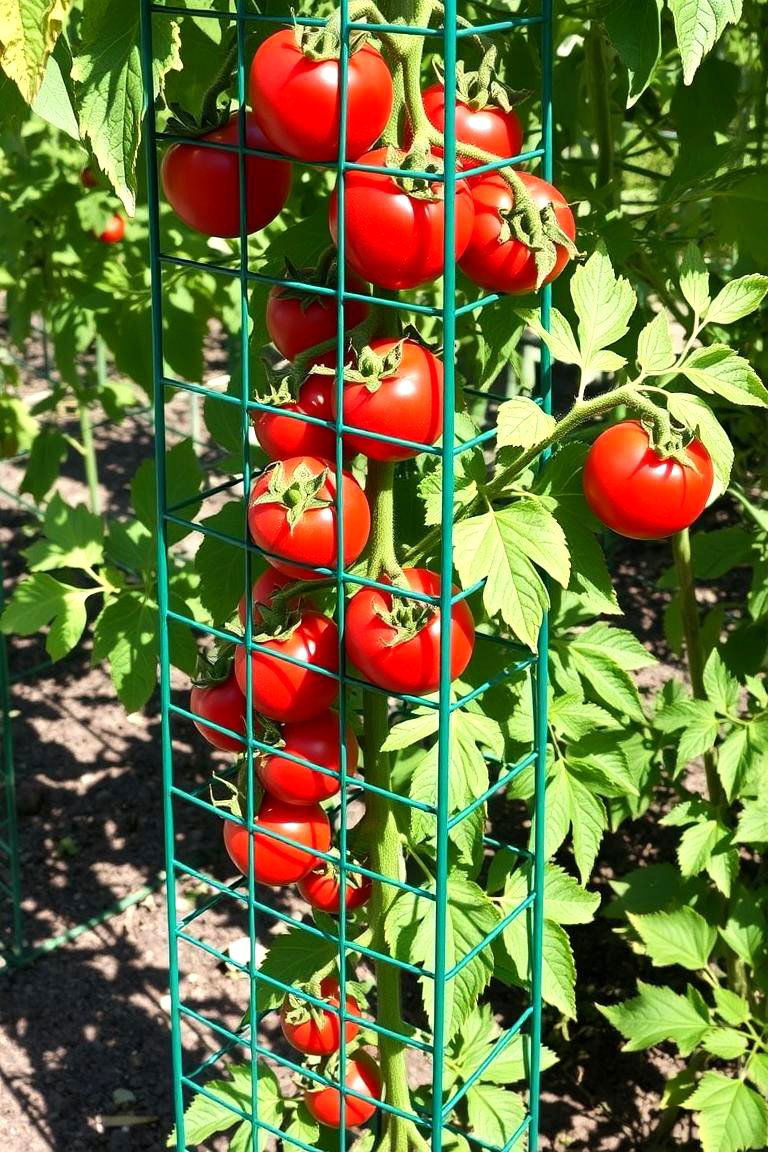
Bringing a classic approach to tomato support, cage trellises are widely used and effective. These cylindrical structures, usually made of wire mesh, encircle the tomato plant, providing support on all sides. The key advantage is their ability to support the entire plant structure, including multiple stems and branches laden with fruit. Choose cages that are tall and wide enough to accommodate the mature size of your tomato variety. Simply place the cage around the young plant or insert it after the plant has started to grow.
9. Wall-Mounted Trellis
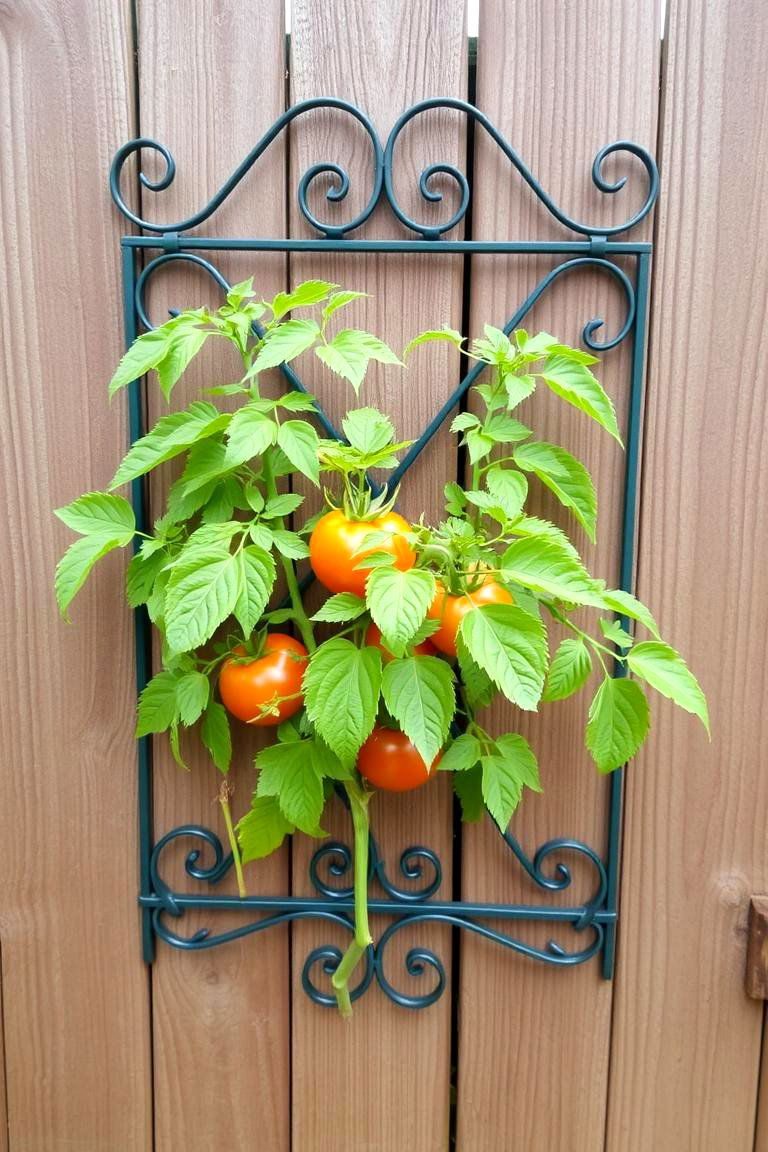
For gardeners with limited ground space, a wall-mounted trellis offers an excellent solution for growing tomatoes vertically. These trellises can be attached to a fence, wall, or even the side of a building. The main benefit is their ability to utilize vertical surfaces, making them ideal for balconies, patios, or small urban gardens. Various designs are available, from simple grids to more decorative fan shapes. Train your tomato plants to grow along the trellis, securing them with ties as needed.
10. Hanging Basket Trellis
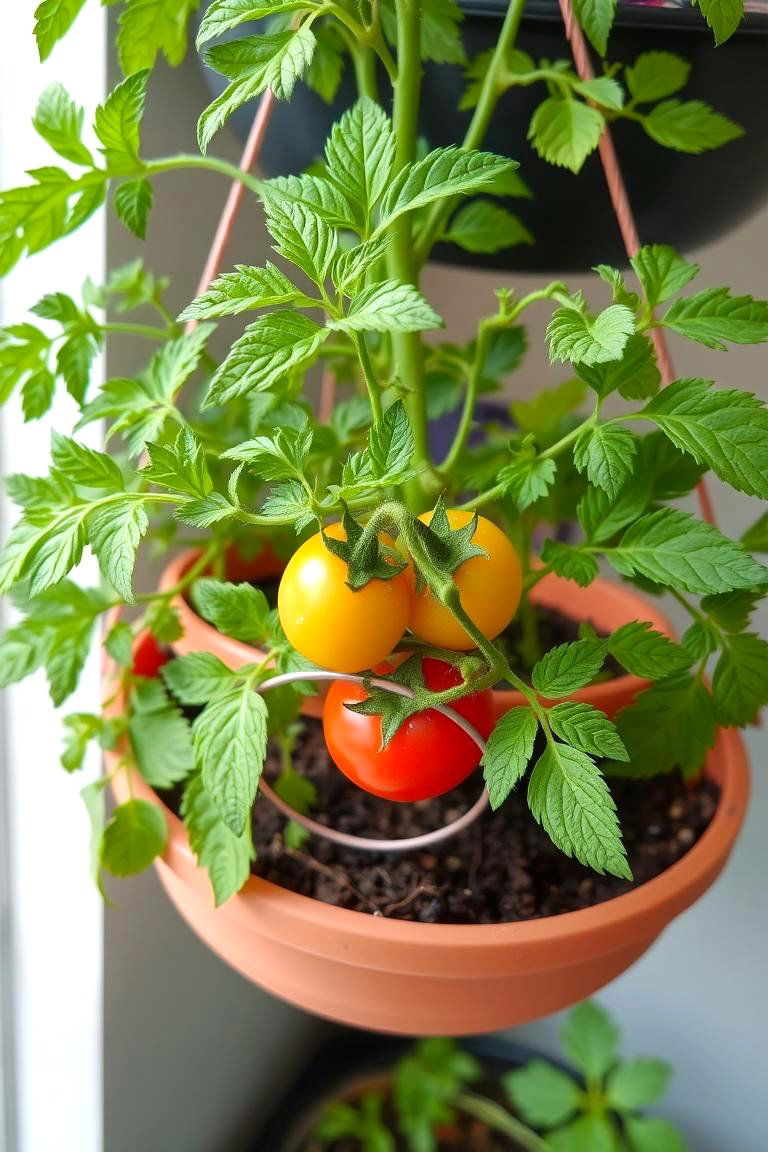
With a hanging basket trellis, you can even grow smaller tomato varieties in hanging baskets. This involves using a small trellis or support structure within the hanging basket to keep the plants upright and the fruits off the soil. The primary advantage is the portability and space-saving nature of hanging baskets, allowing you to grow tomatoes in areas where traditional gardening might not be possible. Choose compact or trailing tomato varieties for best results and ensure the basket is strong enough to support the mature plant and its fruit.
11. Pallet Trellis
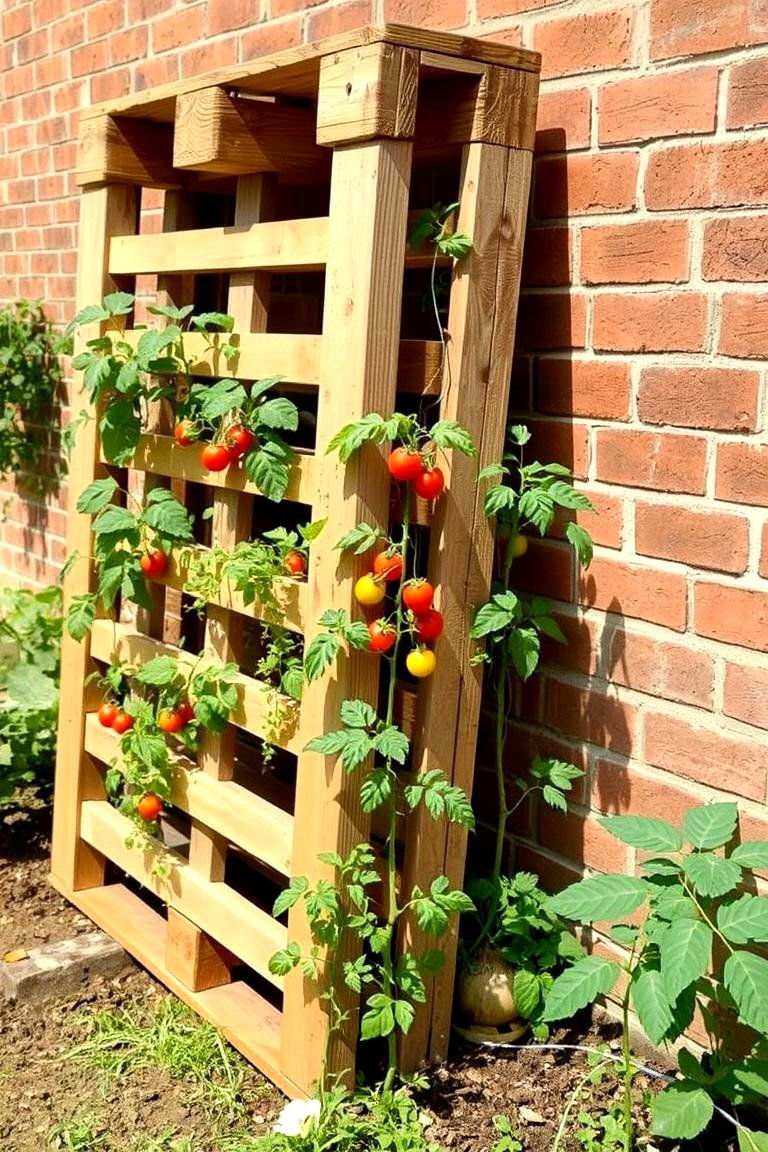
Take an eco-friendly approach by repurposing an old wooden pallet into a functional tomato trellis. Pallets can be easily modified to create a vertical growing structure with built-in support. The key benefit is its cost-effectiveness and sustainability. Simply lean the pallet against a wall or fence, or reinforce it with additional supports. The gaps between the wooden slats provide natural places to train your tomato plants and tie them as they grow.
12. Bamboo Trellis
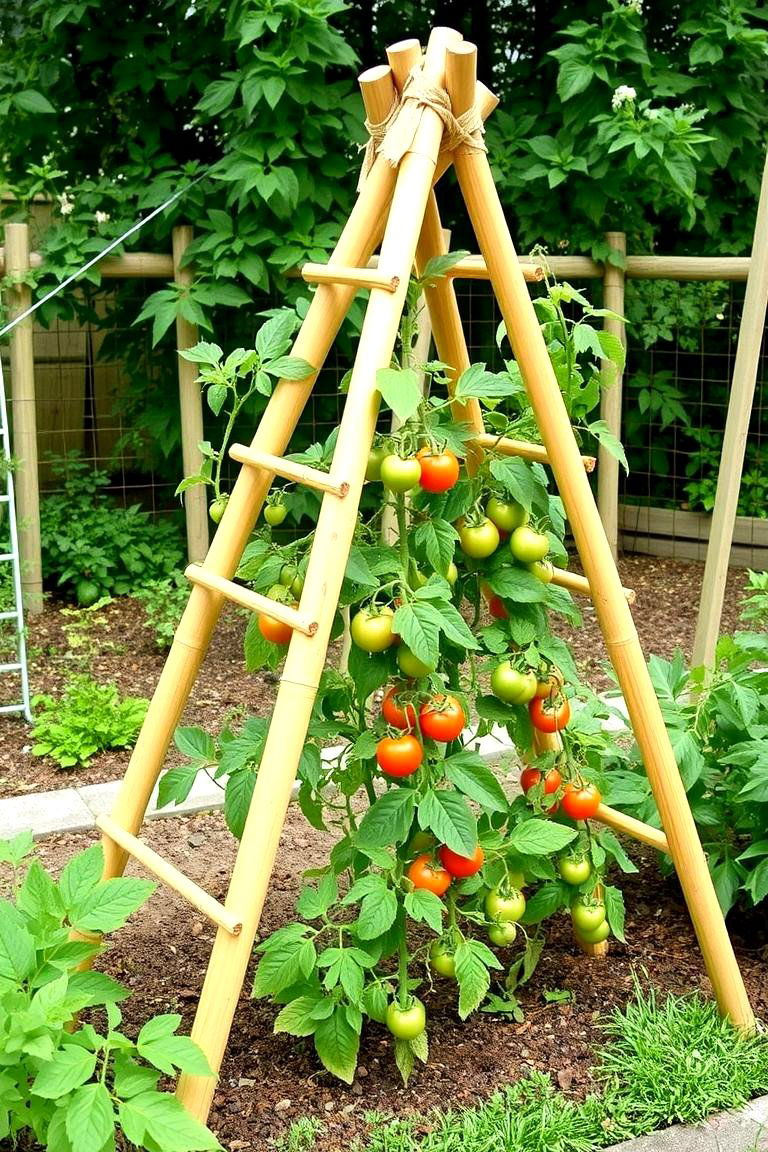
Another natural and sustainable option is a bamboo trellis. Bamboo poles are lightweight yet strong and can be arranged in various configurations to support tomato plants. The main advantage is their natural aesthetic and renewability. You can create a simple teepee, an A-frame, or even a grid-like structure using bamboo poles tied together with twine. Bamboo is also relatively inexpensive and readily available in many areas.
13. PVC Pipe Trellis
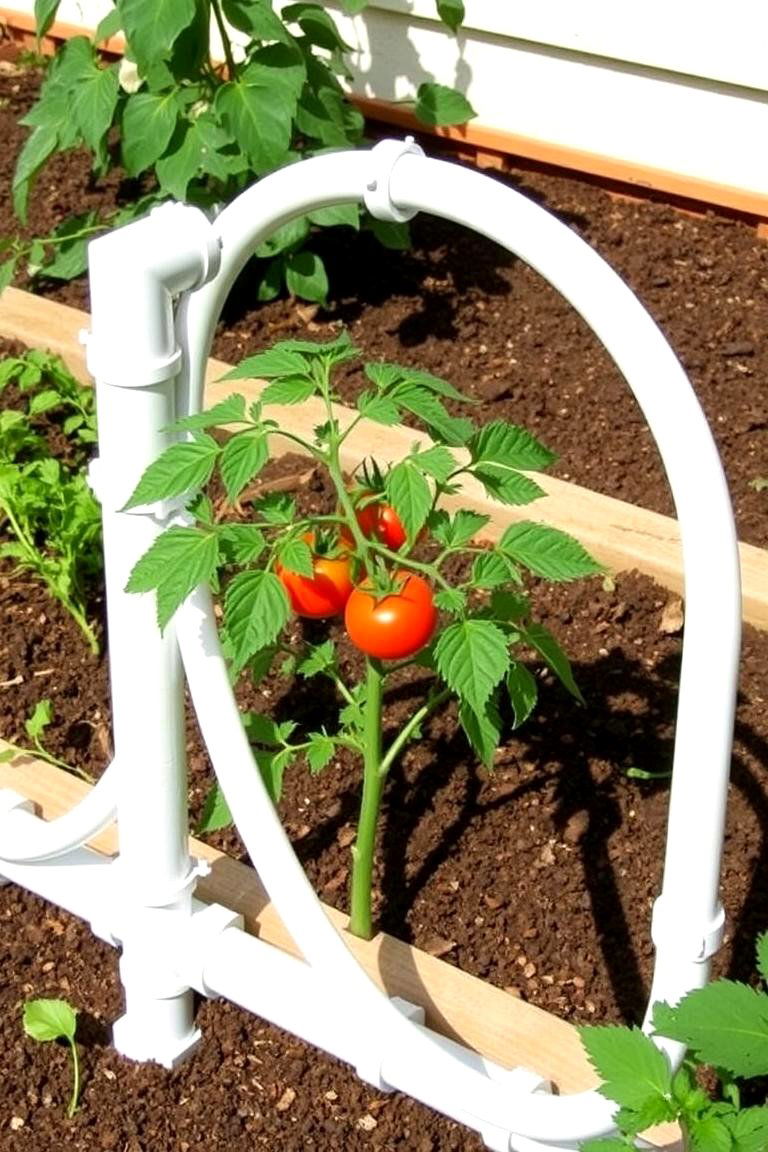
For a lightweight and easy-to-assemble trellis, consider using PVC pipes. These pipes can be cut and connected to create various shapes and sizes of trellises. The key benefit is their durability, resistance to rot, and affordability. You can build simple cages, A-frames, or even more elaborate structures using PVC pipes and connectors. Ensure the structure is stable enough to support the weight of the mature tomato plants, possibly by anchoring it to the ground or using wider base supports.
14. Wooden Ladder Trellis
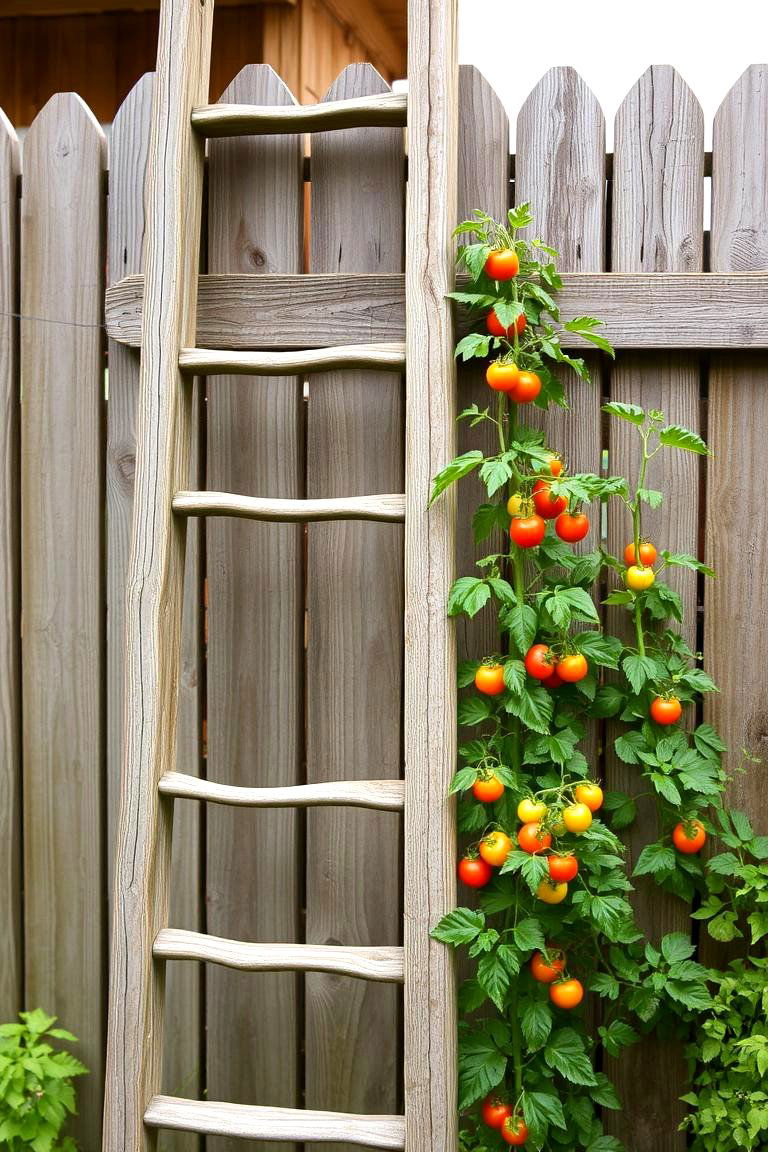
An old wooden ladder can be creatively repurposed into a charming and functional tomato trellis. The rungs of the ladder provide natural support for the tomato plants as they grow upwards. The aesthetic appeal is a significant advantage, adding a rustic touch to your garden. Simply lean the ladder against a wall or fence and train your tomato plants to grow along the rungs, tying them as needed. This is a unique way to combine functionality with garden decor.
15. Metal Rebar Trellis
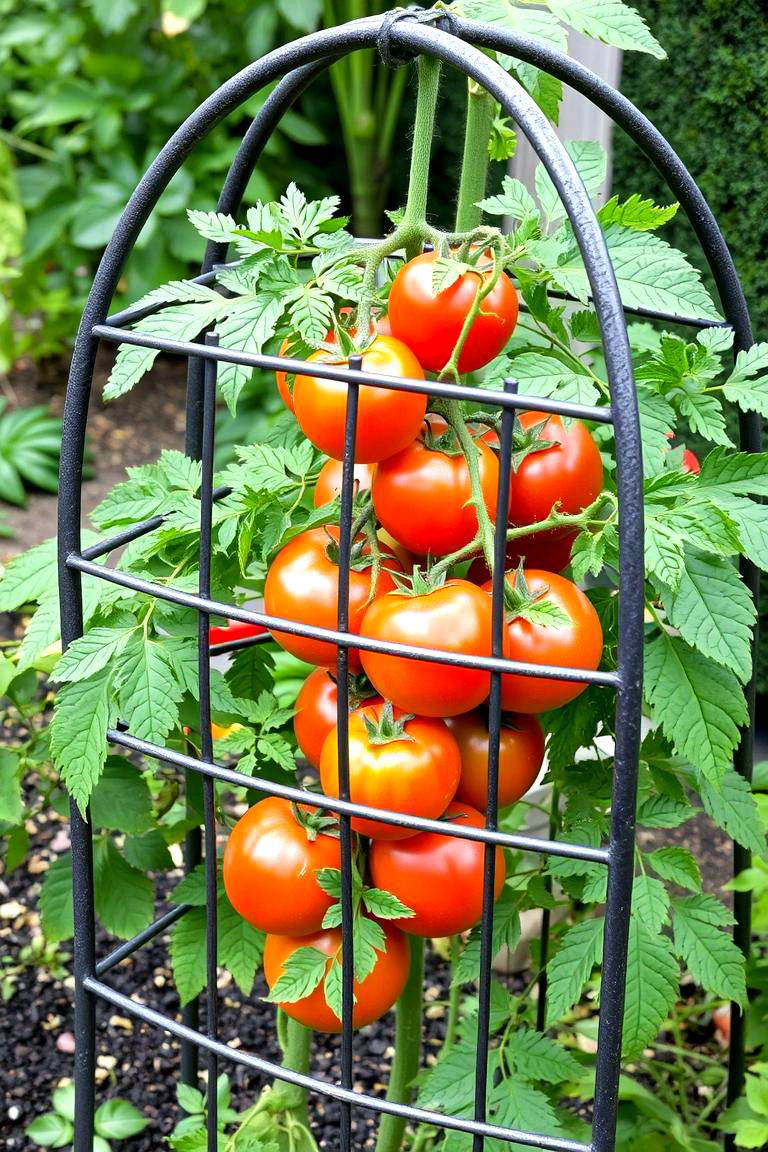
For a very sturdy and long-lasting trellis, consider using metal rebar. Rebar is strong and can be bent into various shapes to create durable support structures for heavy tomato plants. The primary benefit is its exceptional strength and resistance to rust (especially if using epoxy-coated rebar). You can create cages, A-frames, or other custom designs by bending and securing the rebar pieces together. This option requires more effort in construction but offers unparalleled durability.
16. Concrete Reinforcement Mesh Trellis
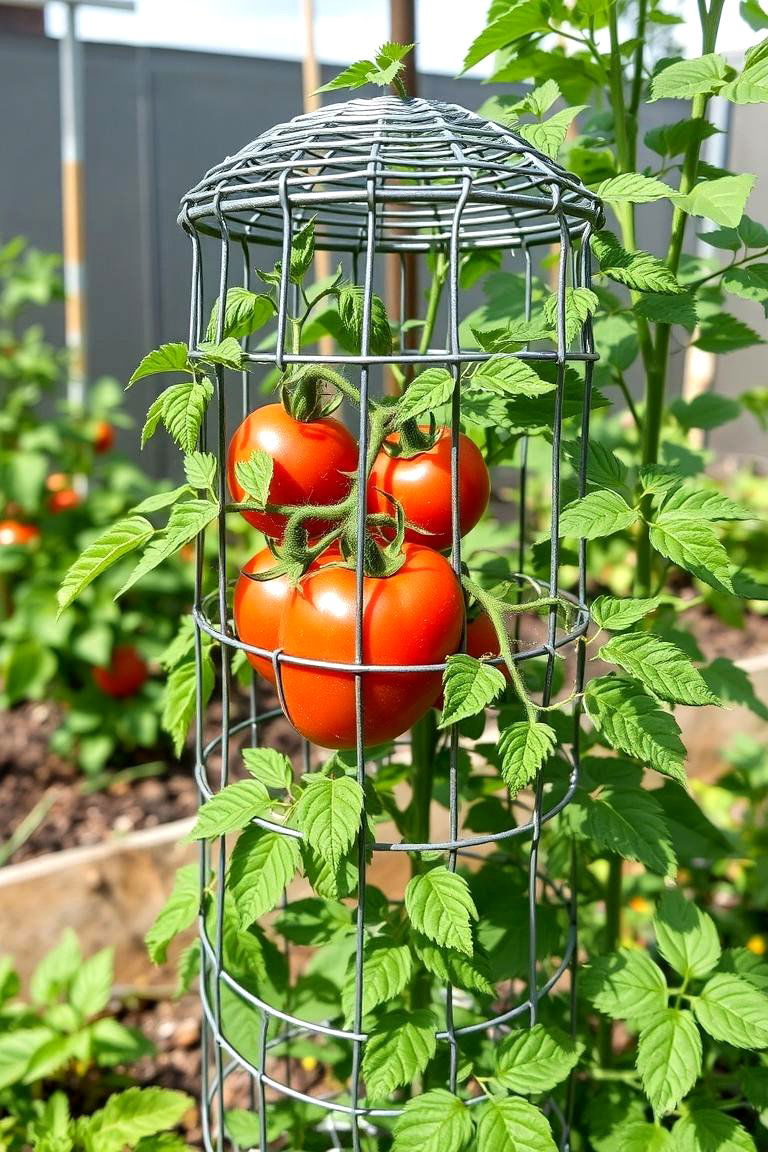
What about using concrete reinforcement mesh to create strong and versatile tomato trellises? This wire mesh is typically sold in large sheets and can be cut and shaped into various forms, such as cylinders or flat panels. The key advantage is its strength and the large grid openings that provide ample support and airflow. Secure the mesh into the desired shape and anchor it firmly in the ground. This is a cost-effective way to create multiple sturdy trellises.
17. Trellis Netting on Frame
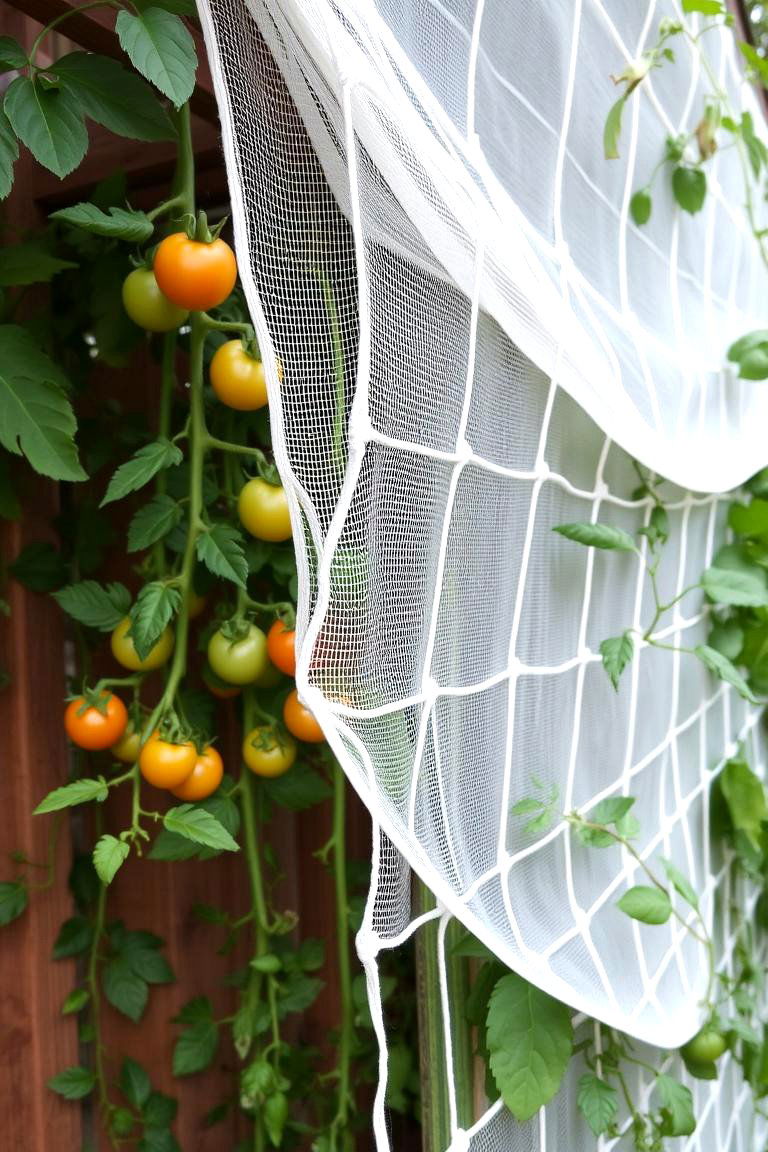
Consider using trellis netting stretched over a frame to support your sprawling tomato plants. This method involves creating a frame, typically from wood or PVC pipes, and then attaching netting with appropriately sized openings. The main benefit is that it provides broad support for the entire plant canopy, allowing multiple stems to be trained upwards. This is particularly useful for indeterminate varieties that tend to produce many lateral branches.
18. DIY Tomato Cage from Wire

Bringing a budget-friendly option, you can easily create your own tomato cages from sturdy wire fencing. This allows you to customize the size and height of the cages to suit your specific needs. The primary advantage is the cost savings compared to pre-made cages. Simply cut a section of wire fencing and bend it into a cylindrical shape, securing the ends together with wire or clips. Ensure the cage is wide and tall enough to accommodate the mature plant.
19. Rolling Tomato Trellis
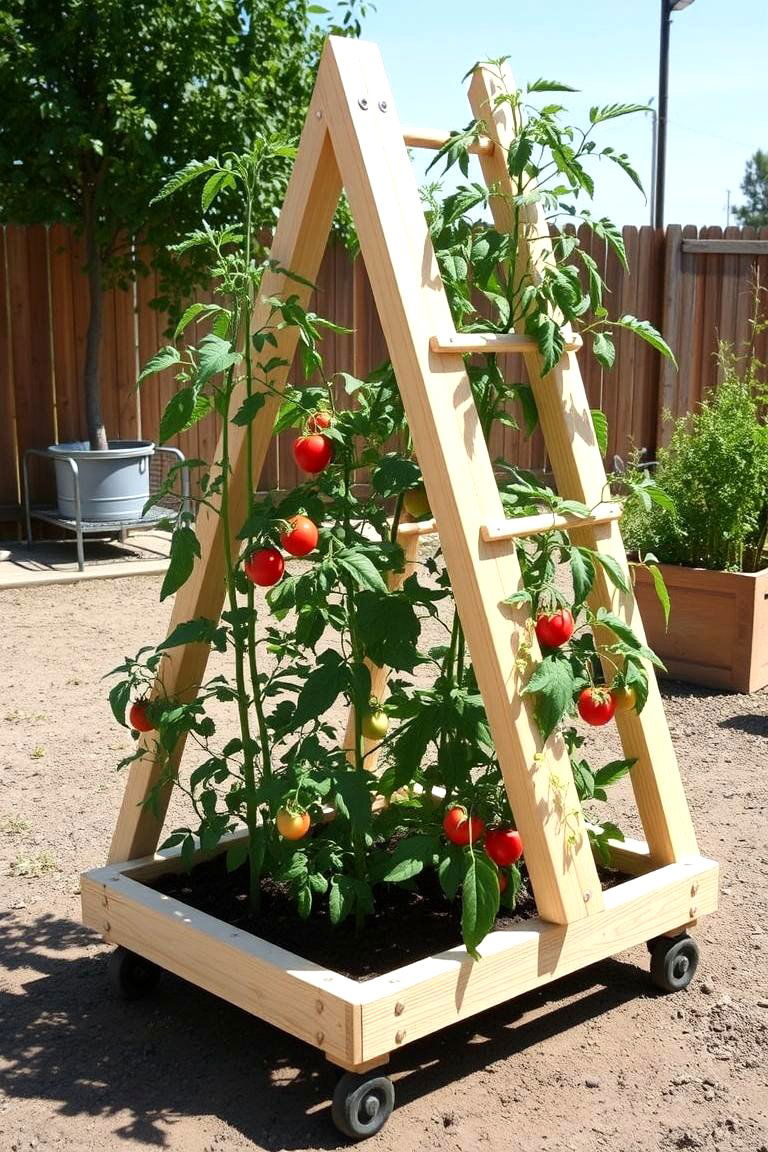
For gardeners who need flexibility in their garden layout, a rolling tomato trellis offers a unique solution. This involves building a trellis structure on wheels or casters, allowing you to easily move your tomato plants as needed to follow the sun or protect them from harsh weather. The key benefit is its mobility and adaptability. This is particularly useful for container gardening or in areas with limited sunlight.
20. Umbrella Trellis

Consider an umbrella trellis, a less common but effective way to support tomato plants. This type of trellis features a central pole with radiating arms that extend outwards and upwards, resembling an open umbrella. The main advantage is the comprehensive support it provides to the entire plant, encouraging an upright and bushy growth habit. Tomato stems can be tied to the arms of the umbrella as they grow.
21. Multi-Tiered Trellis
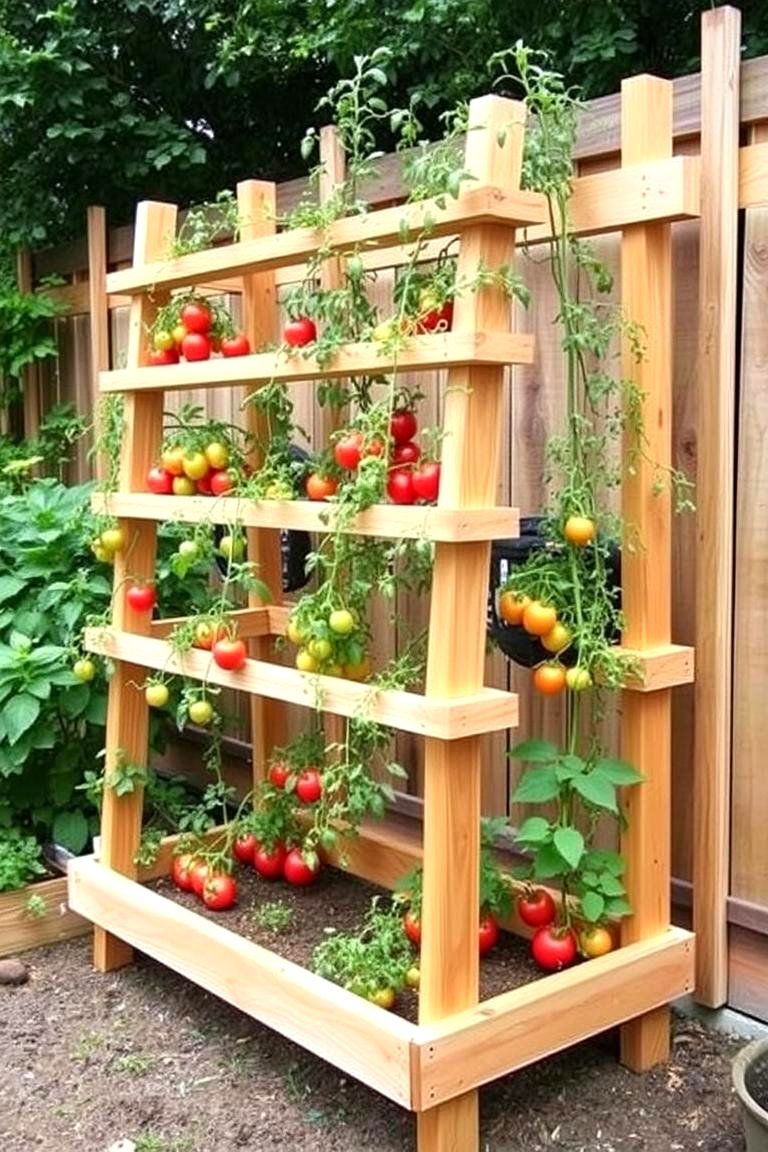
For maximizing vertical space and supporting a large number of tomatoes, a multi-tiered trellis can be an excellent choice. This involves creating a structure with multiple horizontal supports at different heights, allowing you to train plants to grow in layers. The key benefit is the efficient use of space and the ability to grow different types of tomatoes or other climbing plants on the same structure.
22. Living Trellis (e.g., using sunflowers)
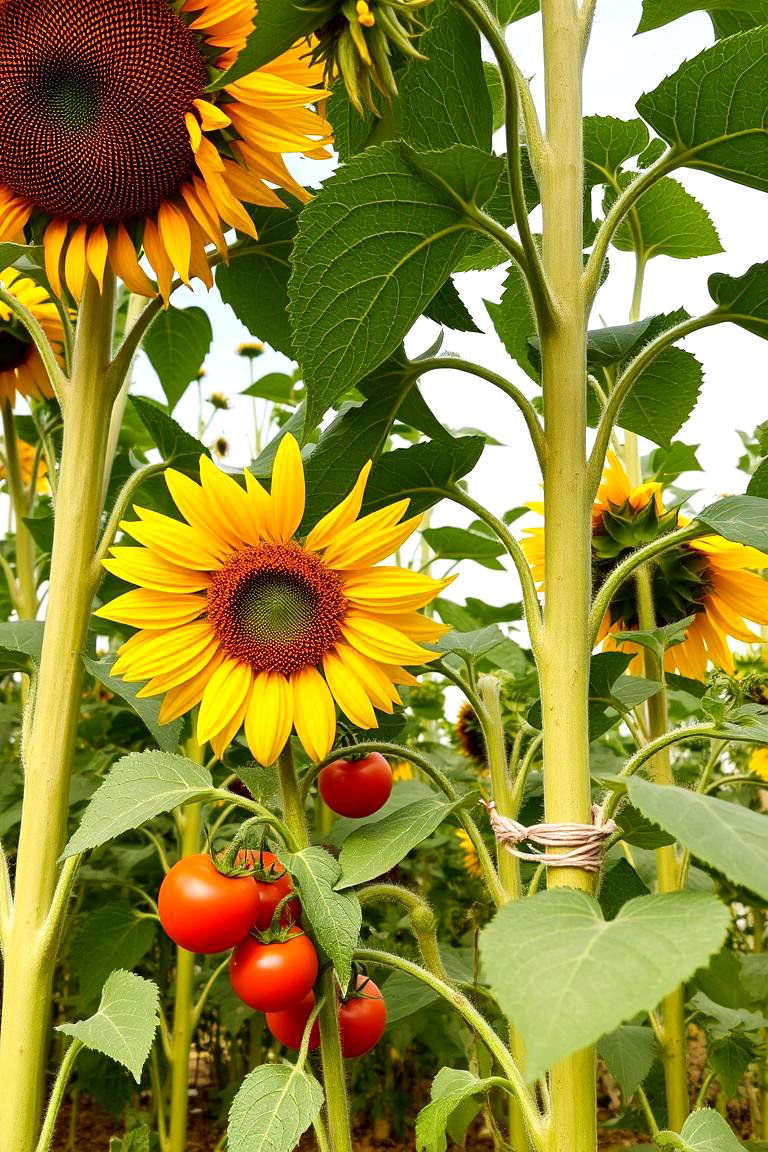
Take a natural approach by using other tall, sturdy plants like sunflowers as a living trellis for your tomatoes. Plant sunflowers close to your tomato seedlings, and as both grow, gently tie the tomato stems to the sunflower stalks for support. The primary advantage is the natural and symbiotic relationship, adding beauty and functionality to your garden. Choose tall sunflower varieties with strong stalks for the best results.
23. Recycled Tire Trellis

Embrace sustainability by using old tires to create a unique and functional trellis. Stack a few tires on top of each other to create a raised growing bed and insert stakes or a cage into the center for supporting the tomato plant. The key benefit is the creative reuse of materials and the added warmth the black tires can provide to the soil. Ensure the tires are clean and free of any harmful chemicals.
24. Obelisk Trellis
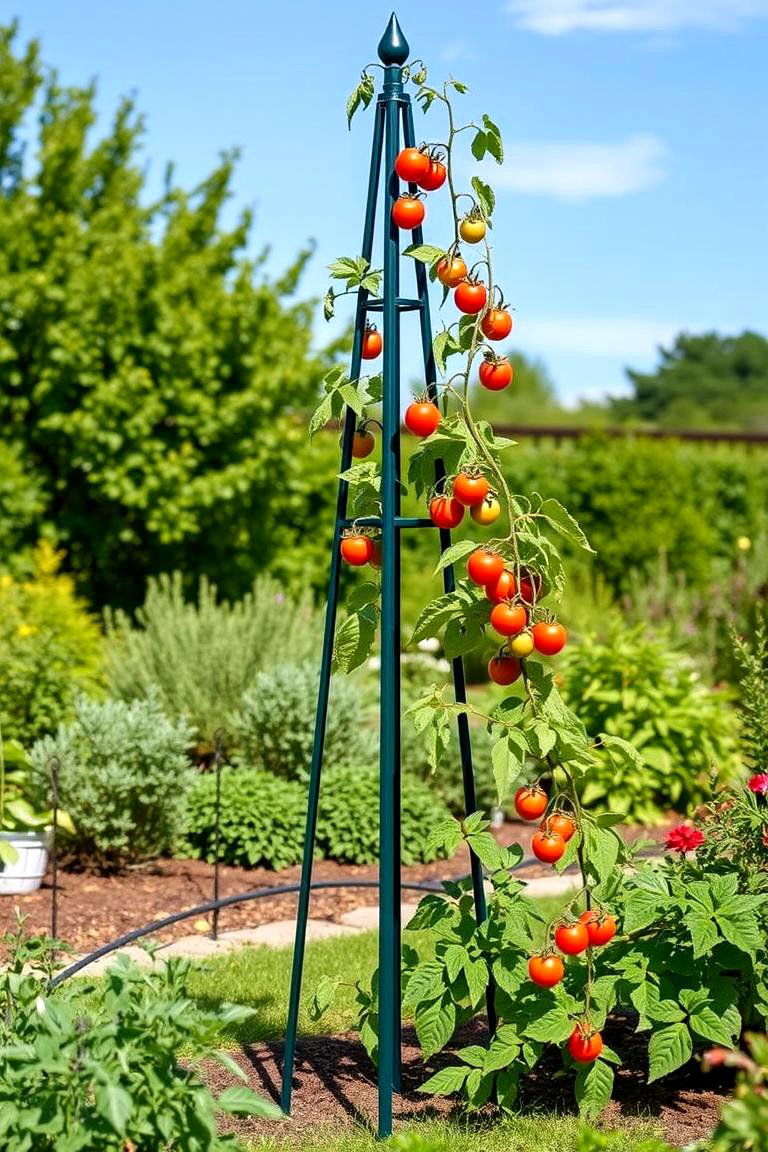
Finally, consider an obelisk trellis for a decorative and functional support for your tomato plants. These typically feature a pointed, pyramid-like structure made from wood, metal, or bamboo. The aesthetic appeal is a major advantage, adding an elegant touch to your garden. Train your tomato plants to grow up the sides of the obelisk, providing both support and visual interest.
Conclusion:
From simple stakes to elaborate multi-tiered systems, the world of 24 tomato trellis ideas offers a plethora of options to suit every gardener's needs and preferences. Whether you prioritize budget-friendliness, durability, aesthetics, or space efficiency, there's a trellis solution to help your tomato plants thrive. By providing the right support, you'll not only keep your precious fruits off the ground, reducing the risk of pests and diseases, but also encourage healthier growth and easier harvesting. So, explore these 24 tomato trellis ideas, choose the ones that best fit your gardening style, and get ready to enjoy a bountiful harvest of delicious, homegrown tomatoes.


